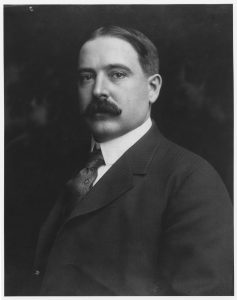Bicentennial 2018: Sears created modern retail in Illinois
By Eric Peterson Of the Daily Herald — January 17, 2018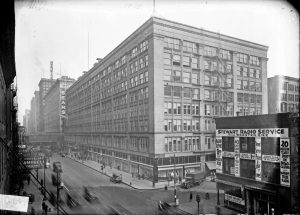
Exterior view of the Sears Roebuck & Co. store on South State Street at Congress Parkway. A portion of a building across the street is visible, view taken above street-level. A vertical Sears sign is visible on the far side of the building. The Sears Roebuck and Co. store, located at 403 South State Street in the Loop community area od Chicago, Illinois, extended a whole block from Congress Parkway north to Van Buren Street. It was built in 1891 by William LeBaron Jenney. This is an example of the Chicago school or Commercial style of architecture. The building was originally called the Leiter Building II.
As the home of Sears since the late 19th century, Illinois is the birthplace of modern retail.
Even today’s colossus, Amazon, can trace the roots of its business model to Sears’ original mail-order business that popularized the notion of buying products at home without first seeing and touching them in person.
“There were some small mail-order companies before, but Sears became the largest, the most successful, the giant,” said Libby Mahoney, senior curator of the Chicago History Museum.
And if it seems strange that such a retailer could grow strong enough to make its headquarters the tallest building in the world as Sears did in Chicago in 1973, consider today’s intense competition among cities to house Amazon’s second headquarters, she said.
It was Chicago’s central position in the nation’s railroad and highway networks that made it a better place for Richard Sears to operate the mail-order watch company he’d started in Minneapolis the previous year, 1886.
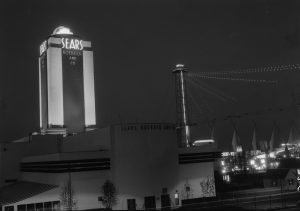
Exterior night view of the Sears Roebuck Building at the Century of Progress International Exposition, Chicago, Illinois, 1933.
In Chicago, Sears partnered with watchmaker Alvah C. Roebuck, leading to the longtime name of the firm being Sears, Roebuck and Co. Its first catalog featuring only watches and jewelry was published in 1888, while its first large catalog of general merchandise came along in 1896. Sears wooed customers with promises of savings gained by eliminating the middleman. It popularized the money-back guarantee to build trust with the consumer, Mahoney said.
The gradual diversification of the company’s products seemed to know no bounds, perhaps best illustrated by the advent of Sears Modern Homes. Between 1908 and 1940, Sears sold about 75,000 such homes around the country by mail-order. Many of the homes, which came in 447 different designs, exist today.
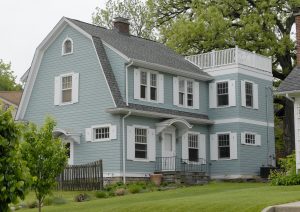
Dave Lothspeich’s Sears home in Libertyville is on the tour of homes. His next door neighbor’s home, pictured here, is also a Sears home.
Such a company at that time was largely dependent on the U.S. Post Office for its success and reliability, Mahoney said.
But eventually, Sears, Roebuck’s original mail-order business began to be threatened by the greater urbanization of the country after World War I. The solution — championed by then-vice president and future company President Robert E. Wood — was the introduction of brick-and-mortar stores in the 1920s.
Many other innovations followed under Wood’s guidance, including getting into the insurance business during the Great Depression with the creation of Allstate Insurance. Like several other Sears-created brands, Allstate eventually would be spun off as an independent company, but not until 1993.
Although Sears has never been a manufacturer, its brands such as Craftsman tools, Kenmore appliances and DieHard batteries helped build the company’s reputation.
Even as the biggest of all, Sears didn’t take customer loyalty for granted, Mahoney said.
“They were really trying to improve the appearance of their products and make them stylish in the 1930s,” Mahoney said. “I think they were really savvy merchants.”
The nation’s economic recovery after World War II was what enabled such imitators as Kmart, Target and Kohl’s, but probably not until the 1970s or 1980s did they start to have a significant impact on Sears’ business, Mahoney said.
Even in the mail-order years, the Chicago-based Montgomery Ward was the country’s distant second-place retailer, despite having started earlier.
“Sears always seemed to have the upper hand,” Mahoney said. Nevertheless, Montgomery Ward’s successfully carved a niche for itself by deliberately selling different products than Sears did, she added.
For the past 25 years, Sears has made its home at the 780-acre Prairie Stone Business Park it created on the west side of Hoffman Estates. Though the now-vanished Poplar Creek Music Theater was probably the first name that put Hoffman Estates on the regional map, Sears was an even bigger one, Mayor Bill McLeod said.

Mail order catalogs now rate a place on the shelves of the Chicago Public Library. Here Ruth Parrington, librarian in the art department of the library, studies early Sears Roebuck catalogs. Bound and dated, the early merchandise directories are used by illustrator writers and fashion designers as a source of authentic material. Volumes in intervals of five years since 1902 picture the styles of the period. Cycles of fashion trends have their start from the illustrations printed in the old books. Some of the current fashions are a revival of the era when Victorianism was a vanishing vogue. A comparison of prices in 1902, 1918 with 1948 also makes the earlier catalogs great escape reading. The catalog Miss Parrington holds features 1902 Ladies Stylish shown in an undated photo. (AP Photo)
“When it was announced, it was a really big deal,” McLeod said. “Sears was an iconic retailer. It obviously brought a lot of attention to the village. Sears made a big difference.”
Among the other developments that have located around it are the Sears Centre Arena — now home to the NBA G League’s Windy City Bulls — and the Chicago region’s 185,000-square-foot Cabela’s store.
The westward expansion of the village’s commercial presence was followed by equivalent residential growth.
“There was very little housing on the west side of the village before Sears came,” McLeod said.
Though headlines today often chronicle the company’s present struggles, reminders of Sears’ heyday are all around. These include the call letters of Chicago radio station WLS — which stands for “World’s Largest Store” for the four years Sears owned the station in the 1920s — and the name of Schaumburg’s massive Woodfield Mall, which honors both Robert Wood and iconic Chicago merchant Marshall Field.
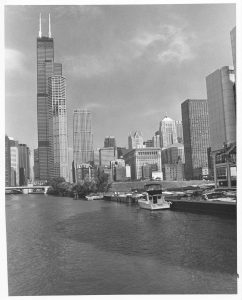
Skyline view from the river looking north from about 800 south, Sears Tower in view, Chicago, Illinois. Aug. 31, 1989
But for a business based in the greater Chicago area for more than 130 years, Sears’ longevity and influence are historic, Mahoney said.
“They’ve hung on longer than the stockyards,” she laughed.
Eric Peterson of the Daily Herald can be reached at epeterson@dailyherald.com.
Editor’s note: The weekly Illinois Bicentennial series is brought to you by the Illinois Associated Press Media Editors and Illinois Press Association. More than 20 newspapers are creating stories about the state’s history, places and key moments in advance of the Bicentennial on Dec. 3, 2018. Stories published up to this date can be found at 200illinois.com.
— Bicentennial 2018: Sears created modern retail in Illinois —

